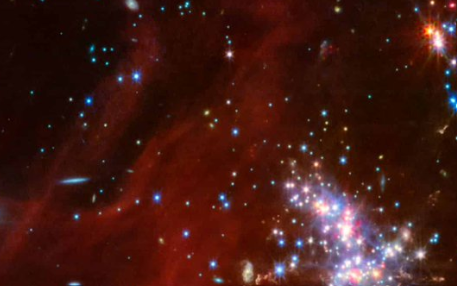The far edges of our galaxy are alive with activity, and astronomers have taken a closer look, revealing dazzling scenes of star formation. Using the powerful James Webb Space Telescope, scientists zoomed in on a distant region called the “Extreme Outer Galaxy,” uncovering clusters of stars and bursts of material ejecting from these hot celestial objects. The clarity and detail captured by the telescope have provided an extraordinary glimpse into this rarely seen corner of the Milky Way.
It’s 7 billion years ago, and the universe’s heyday of star formation is beginning to slow. What might our Milky Way galaxy have looked like? NASA’s James Webb Space Telescope has found clues in the form of a cosmic question mark galaxy. 🌌❓https://t.co/qiRXq6ELYf
📸 STScI. pic.twitter.com/oo0jW4qHXr
— EarthSky (@earthskyscience) September 14, 2024
NASA scientist Mike Ressler, who led the observations, was astonished by the spectacle. He described the scene as “a little bit like a firecracker,” with multiple jets of gas and dust shooting out from the stars in different directions. These vibrant bursts, known as jets, are emitted from the poles of young stars and race out into space, adding to the dynamic nature of the area.
In addition to the lively star clusters, the telescope also revealed distant galaxies beyond the Milky Way, glowing in reddish and greenish hues. Among these are spiral galaxies, which mirror the structure of our own galaxy, providing a striking visual treat.
Located over 58,000 light-years from the center of the Milky Way, the “Extreme Outer Galaxy” is far removed from Earth, which sits about 26,000 light-years from the galactic core. These new observations have allowed scientists to better understand how stars form in different parts of the galaxy, offering fresh insights into the cosmic processes that shape the universe.
The James Webb Space Telescope is a cutting-edge collaboration between NASA, the European Space Agency, and the Canadian Space Agency. It is designed to explore the farthest reaches of the cosmos, helping researchers unlock the secrets of the early universe. Though the telescope’s primary mission is to observe the birth of stars and galaxies from over 13 billion years ago, it also examines planets and moons within our own solar system.
The telescope’s massive mirror, over 21 feet in diameter, is more than twice the size of the mirror on the Hubble Space Telescope, enabling it to capture significantly more light. This extra light allows Webb to peer into ancient and distant parts of the universe, making it possible to see stars and galaxies that formed just a few hundred million years after the Big Bang.
Strangely bright galaxies spotted by the James Webb Space Telescope, called “little red dots”, may have more stars packed into them than any other galaxies we know of. https://t.co/YcxPIQBUbJ
— New Scientist (@newscientist) September 14, 2024
Unlike its predecessor, Hubble, which mostly observes visible light, Webb focuses on the infrared spectrum. This means it can cut through dense cosmic clouds and see regions of space that Hubble can’t, allowing astronomers to reveal hidden details. The longer wavelengths of infrared light slip through cosmic dust, offering clearer views of star formation and other cosmic events.
The Webb telescope is also equipped to study distant planets, known as exoplanets, in our galaxy. Its instruments are designed to detect molecules like water, methane, and carbon dioxide in the atmospheres of these planets. This technology could lead to groundbreaking discoveries about planets beyond our solar system, shedding light on what kinds of worlds exist and what their atmospheres are made of.
The Webb telescope has already uncovered intriguing chemical reactions on a planet 700 light-years away and is now turning its gaze toward the TRAPPIST solar system, a group of rocky, Earth-sized planets that could hold even more surprises. With each new discovery, the telescope is revolutionizing our understanding of the universe.
Key Points:
i. The James Webb Space Telescope captured stunning star formation and dynamic jets of gas in a distant region of the Milky Way, known as the “Extreme Outer Galaxy.”
ii. NASA scientists were amazed by the activity, with multiple jets of material shooting out from young stars, resembling fireworks in space.
iii. The telescope also revealed distant galaxies beyond the Milky Way, including spiral galaxies glowing in reddish and greenish colors.
iv. Webb’s massive 21-foot mirror and focus on the infrared spectrum allow it to see through cosmic clouds and uncover hidden cosmic events.
v. The telescope is also equipped to study distant exoplanets, detecting atmospheric molecules that could reveal new insights into planetary systems beyond our own.
Lap Fu Ip – Reprinted with permission of Whatfinger News

